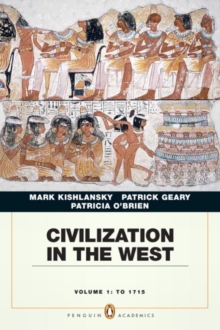For more than 60 years, instructors and their students have looked to Penguin trade paperbacks for state of the art scholarship, accessibility, and fair prices. Pearson Longman, Penguin's sister company, aims to meet those same expectations with textbooks in our Penguin Academics Series.
We've created the Penguin Academics Series with ease of use in mind--the books are conveniently portable and highly readable, with engaging typefaces and interior designs. Concise yet thorough in their coverage of the basics, Penguin Academics titles are ideal for use either by themselves or in combination with other books (such as Penguin Classics).
We made a number of decisions early in the project that we believed contributed to our goal. First, we were not writing an encyclopedia on Western civilization. Information was not to be included in a chapter unless it related to the themes of that chapter. There was to be no information for information's sake, and each of us was called upon to defend the inclusion of names, dates, and events whenever we met to critique one another's chapters. We found, to our surprise, that by adhering to the principle that information included must contribute to or illustrate a particular point or dominating theme, we provided as much, if not more, material than books that habitually list names, places, and dates without any second context.
Second, we were committed to integrating the history of ordinary men and women into our narrative. We believe that islolated sections, placed at the end of chapters, that deal with the experience of women or minority groups in a particular era profoundly distort historical experience. We called this technique caboosing, and whenever we found ourselves segregating women or families or the masses, we stepped back and asked how we might recast our treatment of historical events to account for a diversity of actors. How did ordinary men, women, and children affect the course of historical events? How did historical events affect the fabric of daily life for men, women, and children from all walks of life? We tried to rethink critical historical problems of civilization as gendered phenomena. To assist us in the endeavor, we engaged two reviewers whose sole responsibility was to evaluate our chapters for the integration of those social groups into our discussion.
We took the same approach to the coverage of central and eastern Europe that we did to women and minorities. Even before the epochal events of 1989 that returned this region to the forefront of international attention, we realized that in too many textbooks the Slavic world was treated as marginal to the history of Western civilization. Thus, with the help of a specialist reviewers, we worked to integrate more of the history of eastern Europe into our text than is found in most others, and to do so in a way that presented the regions, their cultures, and their institutions as integral rather than peripheral to Western civilization.
To construct a book that students would want to read, we needed to develop fresh ideas about how to involve them with the material, how to transform them from passive recipients to active participants. We borrowed from computer science the concept of being "user-friendly." We wanted to find ways to stimulate the imagination of the student, and the more we experimented with different techniques, the more we realized that the most effective way to do this was visually. It is not true that contemporary students cannot be taught effectively by the written word; it is only true that they cannot be taught as effectively as they can by the combination of words and images: the pictorial chapter openers; the large number of maps; the geographical tours of Europe at certain times in history; and the two-page special feature essays, each with its own illustration.

